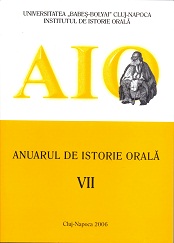IMAGINAR SOCIAL ŞI MITOLOGIE POLITICĂ. REPERE TEORETICE (II)
SOCIAL IMAGINARY AND POLITICAL MYTHOLOGY: A THEORETICAL FRAMEWORK
Author(s): Sidonia Nedeianu GramaSubject(s): History
Published by: Argonaut
Summary/Abstract: The paper attempts to outline the large area of research on symbolism, as focused in social sciences, primarily in history and social psychology, as well. It elicits different meanings and features of this field - which has been lately an attractive, though highly demanding object of study-, pointing out some clarifications on the fuzzy concepts it deals with. In what concerns the relevance of this topic for oral history, the implicit assumption of the paper is that collective memories, at the core of the oral history approach, are inextricably mixed with social imaginary. Therefore, a prior comprehension of the vast world of symbols and a peculiar awareness of their complexity and subtleties are needed. The first part of the paper presents a general theory on imaginary, particularly Gilbert Durand’s work on mythodologie. In the meantime, outlining the world of symbols, with their characteristics and social functions, an emphasis is put on their dual nature, as both benign and malign potentiality, which might carry unexpected effects on human personality and cultures. The study considers as well the imaginary in the history, and the historical imaginary. Drawing mainly on the work of Jacques Le Goff, it suggests that the approach on mentalities and imaginary - the fruitful, even though rather ambiguous and vaguely defined concepts of the „new history”- could be usefully focused at the level of social representations, a more concrete and nuanced notion borrowed from social psychology. In the second part of this study, which is to be published in the next issue of the Annual of Oral History, I am going to describe some classic characters of the political mythology, such as the savior or the charismatic leader in history. As a matter of fact, this recurrent and powerful myth of the Romanian social imaginary played a crucial role in the 1989 Romanian revolution, as it is largely analyzed in a previous article that I published, based on my 1996 BA thesis. In conclusion, this paper advocates a comprehensive approach on social imaginary, as a constant dimension of humanity and therefore, an important object of social sciences. Since it warns of the symbols’ mixed benign and malign effects on both individuals and cultures, the paper finally suggests a balanced attitude in approaching the world of symbols, neither enthusiastically overwhelmed by their power, nor reluctantly neglecting them as mere non-rational forces.
Journal: Anuarul Institutului de Istorie Orală
- Issue Year: 2006
- Issue No: VII
- Page Range: 35-56
- Page Count: 22
- Language: Romanian

